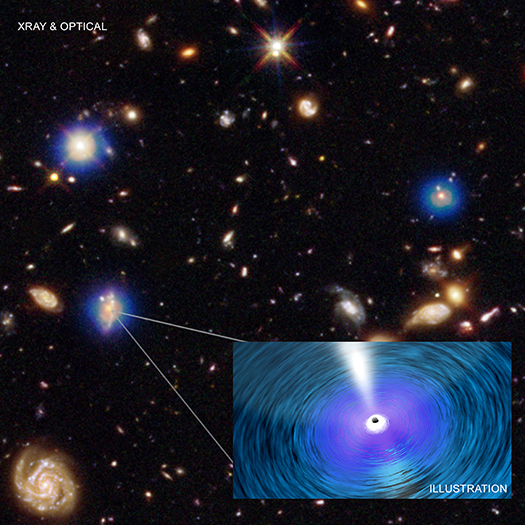The Billion-year Race Between Black Holes and Galaxies: Guang Yang

Guang Yang
We welcome Guang Yang, a 4th-year Astronomy graduate student at Penn State, as a guest blogger. Guang led one of the two studies reported in our new press release about the evolution of supermassive black holes and galaxies. Before studying at Penn State, he obtained his astronomy B.S. degree at the University of Science and Technology of China.
Supermassive black holes, with masses over million times that of our sun, sit in the centers of galaxies. The evolution of these black holes and their host galaxies in the past billions of years of cosmic history is still an unsolved mystery. A prevailing idea is that black hole growth is synchronized with host-galaxy growth, i.e., the ratio between black hole and galaxy growth is constant. "What a beautiful theory," I told my advisor Prof. Niel Brandt, and colleagues Dr. Chien-Ting Chen and Dr. Fabio Vito. "But is it true?” I asked. “Has someone proved it?"
We searched large amounts of literature but did not find dedicated works proving the idea, although it is widely quoted in published papers. "Then why not prove it with observations?" said my advisor. "It can be a great thesis topic for you." I was so happy that my thesis topic was settled and I even dreamed about how our data might nicely support the theory.
We painstakingly analyzed a large amount of data in the Chandra Deep Field-South & North and COSMOS surveys. We successfully tracked the black hole and galaxy growth in the distant universe with NASA's Chandra, Hubble, Spitzer, and other observatories. The observations are so deep that we can study the evolution of black holes and their host galaxies 12 billion years in the past, when the Universe was less than 15% of its current age.
"It is like watching a race between black holes and their host galaxies," I joked with my colleagues, "I'm pretty sure nothing is missed, even though the race lasts for billions of years." After obtaining the growth rates for black holes and galaxies, we eagerly compared them, thinking that we can finally prove the elegant theory of lockstep evolution.
The results turned out to be surprisingly different from what we expected. Our data strongly disagree with the synchronization of black hole and galaxy growth. Instead, our work shows that black holes in big galaxies are growing much faster than small galaxies. It would be a little upsetting to kick out such a beautiful theory, but we must accept the results, since the Universe appears to work that way.
By tracking the growth history of black holes and galaxies, we also predicted the accumulated black-hole mass in the current cosmic epoch, that is, the time we are living now. We found big galaxies have black holes with larger masses than we expected compared to small galaxies. If galaxy A is 10 times bigger than galaxy B, then its black hole is 100 times bigger than galaxy B's black hole. The story appears to be quite different for big and small galaxies. In big galaxies, the black holes win the race against their hosts. But they lose in small galaxies.
The progress represented by our discovery is quite dramatic. It teaches me that idealized theories might not be true, no matter how beautiful they are.
- Log in to post comments

